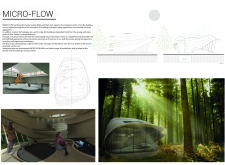5 key facts about this project
Sustainability is at the core of the "Micro-Flow" project. The building is designed to operate independently from conventional utility systems, utilizing solar panels and rainwater harvesting technologies. This self-sufficiency not only reduces the carbon footprint of the dwelling but also minimizes long-term operational costs for its inhabitants. The architectural layout features open spaces that allow for natural light to penetrate deeply into the interior, fostering a connection with the surrounding environment.
The use of superlative concrete as the primary structural material provides durability and allows for complex forms. Recycled aggregates incorporated in the concrete mix further enhance the project's ecological credentials. The extensive use of glass in the design contributes to visual transparency, creating an interplay between indoor and outdoor spaces while providing energy-efficient thermal management.
Unique Design Approaches
The "Micro-Flow" project distinguishes itself through its adaptive spatial organization. The layout is designed to facilitate fluid movement between different areas, including multifunctional zones for living, dining, and working. This approach aligns with modern sociocultural shifts toward more integrated living arrangements. The concept of participatory architecture is also emphasized, allowing residents to reshape their environments through flexible furniture arrangements and movable partitions.
In addition, the integration of smart home technologies within the architectural framework enables efficient resource management and climate control. This approach enhances user experience and promotes energy conservation, aligning with broader trends in sustainable design. The project takes into account local climatic conditions, ensuring that the architectural elements work harmoniously with the environment.
Efficient Use of Materials and Resources
Materiality plays a crucial role in the "Micro-Flow" project. In addition to superlative concrete, the architectural design incorporates steel and composite materials to ensure structural integrity while providing aesthetic quality. These materials are selected not only for their performance characteristics but also for their environmental impact. The consideration of life cycle assessments in material selection aligns with the project’s overarching sustainability goals.
The combination of efficient construction practices and resource-conscious design supports the project's aim to minimize environmental disruption. By blending modern technology with eco-friendly principles, "Micro-Flow" serves as a model for future architectural endeavors focused on sustainability.
For those interested in a deeper understanding of the design and structure of the "Micro-Flow" project, exploring the architectural plans, sections, and overall designs will provide insight into the innovative approaches employed. Engaging with these elements can enhance appreciation of the project's unique contributions to contemporary architecture.























